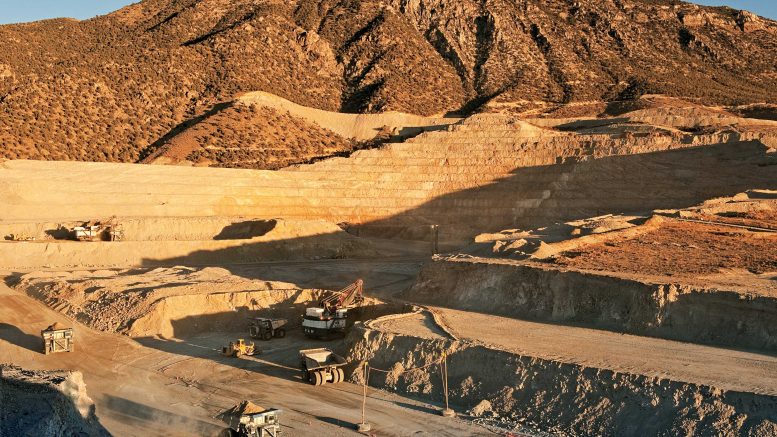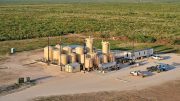The U.S. is fertile ground for a variety of minerals, and Canadian companies are active throughout the land. The Northern Miner presents its top-10 list of the biggest Canada-based firms with substantial assets in the U.S., by market capitalization.
1. BARRICK GOLD
Market cap: US$34.2 billion
In March 2019, Toronto-based Barrick Gold (TSX: ABX; NYSE: GOLD) and Newmont Goldcorp (TSX: NGT; NYSE: NEM) combined their Nevada operations into a joint venture.
Barrick is the operator and owns 61.5% of the Nevada Gold Mines joint venture. The company says the combined entity represents the world’s largest gold-producing complex, comprised of eight mines that produced 4.1 million oz. gold in 2018.
Barrick considers three of these mines “tier-one” assets: Cortez; Goldstrike–Carlin and Turquoise Ridge–Twin Creeks. Barrick says a tier-one asset is a low-cost mine with more than 10 years of mine life, producing more than 500,000 oz. gold per year.
Also in Nevada, the company holds the Goldrush–Fourmile development project, which Barrick says has the potential to become a tier-one gold mine (Fourmile is excluded from the joint venture).
Barrick also owns the Golden Sunlight mine in southwestern Montana, which produced 32,000 oz. gold in 2018.
2. TECK RESOURCES
Market cap: US$9.6 billion

Teck Resources’ Red Dog high-grade zinc mine in Alaska. Credit: Teck Resources
Vancouver-headquartered base metals miner Teck Resources (TSX: TECK.B; NYSE: TECK) owns the massive Red Dog zinc mine, 170 km north of the Arctic Circle in northwest Alaska. The mine was developed through an operating agreement with landowner NANA, a corporation owned by the Iñupiat people of the region. Red Dog has operated since 1989, and could continue until 2031. In 2018, it produced 583,000 tonnes zinc-in-concentrate, up 7% from 2017.
In northeast Washington, Teck owns the Pend Oreille underground zinc mine, which it restarted in 2014 after being on care and maintenance since 2009. In 2018, the mine yielded 30,000 tonnes zinc-in-concentrate. Pend Oreille’s reserves are nearly exhausted, and is scheduled for suspension in the third quarter of 2019.
3. KINROSS GOLD
Market cap: US$7.1 billion

Kinross Gold’s Round Mountain gold mine in Nye County, Nevada. Credit: Kinross Gold.
Kinross Gold (TSX: K; NYSE: KGC) owns and operates a trio of open-pit, heap-leach gold mines in the U.S.: Fort Knox, Round Mountain and Bald Mountain.
Fort Knox, near Fairbanks, Alaska, produced its 7 millionth ounce of gold in 2016. In 2018, the mine delivered 256,000 equivalent oz. gold (including silver credits). The company is in the midst of completing the Gilmore expansion, which will extend the mine’s life through to 2030.
At Round Mountain in central Nevada, Kinross produced 386,000 equivalent oz. gold in 2018, with one of those ounces representing the site’s 15 millionth. In the second quarter of 2019, the company hit production at Round Mountain’s Phase W expansion, which will keep the mine humming until 2027.
Bald Mountain is on the southern extension of the Carlin trend, 110 km southeast of Elko, Nevada. The mine yielded 285,000 equivalent oz. gold in 2018 and sits within the largest private mining land package in the country, Kinross says. In the second quarter of 2019, the company hit production at the Vantage Complex on the property, which includes a new heap-leach pad and associated processing facilities.
4. LUNDIN MINING
Market cap: US$3.2 billion

Lundin Mining’s Eagle nickel-copper mine in Michigan’s Upper Peninsula. Credit: Lundin Mining.
On Michigan’s Upper Peninsula, Lundin Mining (TSX: LUN) has been producing nickel and copper concentrates since achieving commercial production in 2014 at its wholly owned Eagle underground mine.
Eagle operates at 2,000 tonnes per day, and miners access the deposit via a surface ramp and extract the ore via transverse bench-and-fill stoping. Lundin is driving ramp access to the Eagle East deposit, which will extend the mine’s life to at least 2023. The company expects the first ore from Eagle East to reach the mill in the fourth quarter of 2019.
Trucks carry Eagle’s ore 105 km for processing at the Humboldt mill, which processed iron ore before Lundin converted and refurbished the facility.
Lundin expects to produce between 12,000 to 14,000 tonnes nickel and 12,000 to 15,000 tonnes copper at Eagle in 2019.
5. NOVAGOLD RESOURCES
Market cap: US$2.3 billion

An undated photo of the camp at NovaGold Resources’ Donlin Gold project in Alaska, now a joint venture with Barrick Gold. Credit: NovaGold Resources.
Vancouver-based NovaGold Resources (TSX: NG) is shepherding its massive 50%-owned Donlin gold project in Alaska through to production, together with partner Barrick Gold.
This exceptionally large and rich deposit hosts measured and indicated resources of more than 630 million tonnes grading 2.24 grams gold per tonne, for 39 million contained oz. gold. Donlin’s proven and probable reserves hold 33.8 million oz., or 87% of the gold in the resource estimate.
The project’s 2011 feasibility study contemplated an open-pit operation, which would churn through 53,500 tonnes per day to produce 1.1 million oz. gold per annum on average over a 27- year mine life. The project would cost US$6.7 billion.
In its second-quarter 2019 report to investors, NovaGold said it has US$157 million on hand, and plans to spend US$24 million in 2019. The company is advancing key state permits related to the project’s required transportation corridor, natural gas pipeline and tailings storage dam.
The company is also preparing a study to inform an expected optimized project development plan.
6. SSR MINING
Market cap: US$2.1 billion
SSR Mining (TSX: SSRM; NASDAQ: SSRM) owns the Marigold gold mine on the Battle Mountain–Eureka trend in Humboldt County, Nevada.
SSR Mining (TSX: SSRM; NASDAQ: SSRM) owns the Marigold gold mine on the Battle Mountain–Eureka trend in Humboldt County, Nevada.
Marigold is a heap-leach operation that has operated since 1989. SSR acquired the mine in 2014 for US$275 million.
In 2018, Marigold produced 205,000 oz. gold. A 2018 mine plan update estimates it will produce an average of 211,000 oz. gold per year until the end of its mine life in 2027.
In June 2019, the company announced exploration and technical work results from the Red Dot gold deposit at the Marigold property, which should allow SSR to extend the mine’s life to the early 2030s, without expansion spending.
SSR is spending US$7.5 million on exploration in and around Marigold in 2019, including an exploration program on recently acquired land immediately south of the project.
7. HUDBAY MINERALS
Market cap: US$850 million

Hudbay Minerals Rosemont copper project in Arizona. Credit: Hudbay Minerals.
Established base-metals miner Hudbay Minerals (TSX: HBM; NYSE: HBM) is focused on putting its Rosemont copper project into production, 50 km southeast of Tucson, Arizona.
Rosemont hosts proven and probable reserves of 537.1 million tonnes grading 0.45% copper, 0.012% molybdenum and 4.58 grams silver per tonne.
The planned US$1.9-billion, open-pit operation would have a 19-year mine life. In the first 10 years, Rosemont would produce 127,000 tonnes copper per year at cash costs of $1.14 per lb. copper.
In March 2019, Hudbay approved a US$122-million early works program at Rosemont and planned to start construction by the end of 2019, with first production scheduled for 2022.
Development at Rosemont hit a hurdle in July when an Arizona court challenged the U.S. Forest Service’s 2017 final record of decision in favour of the project. Hudbay is appealing the decision.
As planned, Rosemont would be the third-largest copper mine in the U.S., Hudbay says.
8. MCEWEN MINING
Market cap: US$770 million

The gold processing plant at McEwen Mining’s Gold Bar project site in Nevada. Credit: McEwen Mining.
In May 2019, precious metals miner McEwen Mining (TSX: MUX; NYSE: MUX) declared commercial production at its Gold Bar gold mine in Eureka Country, Nevada.
In the second quarter of 2019, the mine produced 7,940 oz. gold, including pre-commercial and commercial production. The company lowered Gold Bar’s 2019 production guidance from 50,000 oz. gold to 42,000 oz., due to ramp-up delays at the mine.
Gold Bar has a 7.4-year mine life and should produce an average 60,000 oz. gold per year.
Resources at Gold Bar include 30 million tonnes in the measured and indicated categories, grading 0.92 gram gold per tonne for 819,000 contained oz., and another 7.6 million inferred tonnes grading 0.91 gram gold, for 201,000 oz. gold.
McEwen has earmarked US$5 million for exploration at Gold Bar in 2019 — targeting Gold Bar South — to advance permitting, with development planned for late 2020. The company expects Gold Bar South’s resources will extend the mine life at least one year.
9. EQUINOX GOLD
Market cap: US$670 million

Pit operations at Equinox Gold’s Mesquite gold mine in California. Credit: Equinox Gold.
Equinox Gold (TSXV: EQX; US-OTC: EQXFF) owns the Mesquite gold mine in southern California’s Imperial County, which is scheduled to produce between 125,000 and 145,000 oz. gold in 2019.
The company paid US$158 million for the producing asset in 2018, and the mine has three years of remaining mine life, plus three years of residual leaching.
Mesquite’s measured and indicated mineral resources stand at 128 million tonnes grading 0.46 gram gold per tonne for 1.9 million contained oz. gold.
To extend Mesquite’s life, Equinox is working to convert resources to reserves, examining historic mineralized dumps and leach pads, and investigating exploration opportunities near the mine, and regionally.
Elsewhere in California, Equinox is advancing its prefeasibility-stage Castle Mountain gold project. The company envisions restarting the historic mine in two phases to produce 2.8 million oz. gold over a 16-year mine life.
Phase-one construction is set to begin in the second half of 2019, with production to follow in 2020. Castle Mountain has defined proven and probable reserves of 198 million tonnes grading 0.56 gram gold per tonne, for 3.56 million contained oz. gold.
10. PREMIER GOLD MINES
Market cap: US$420 million

Barrick Gold and Premier Gold Mines’ South Arturo gold project in Nevada. Credit: Premier Gold Mines.
Thunder Bay-based gold junior Premier Gold Mines (TSX: PG) holds 40% of the construction-phase South Arturo gold project in Elko Country, Nevada. Barrick Gold owns the other 60% and operates the project.
Construction is advancing on two fronts on-site: at El Nino, and phase one.
El Nino is an underground development to extract gold beneath the historic phase-two pit, with ore mined in the second half of 2019.
The phase-one open pit is an extension of the past-producing Dee pit, and is scheduled to produce in 2020.
On a 40% basis, South Arturo hosts proven and probable reserves of 2.8 million tonnes grading 3.01 grams gold per tonne, for 275,000 oz. gold.
Premier also owns the past-producing Cove gold-silver property in north Nevada, where Barrick Gold can earn a 60% stake by spending US$22.5 million on exploration before June 30, 2022.
In 2018, Premier completed a preliminary economic assessment for the Cove deposit (excluded from the Barrick deal), which outlined indicated resources of 950,000 tonnes grading 11.2 grams gold per tonne and 29.5 grams silver, for 342,000 oz. gold and 900,000 oz. silver. Inferred resources at Cove total 3.7 million tonnes grading 11.20 grams gold and 20.9 grams silver, for 1.3 million oz. gold and 2.5 million oz. silver.





Be the first to comment on "Top 10 Canada-based companies with substantial US assets"